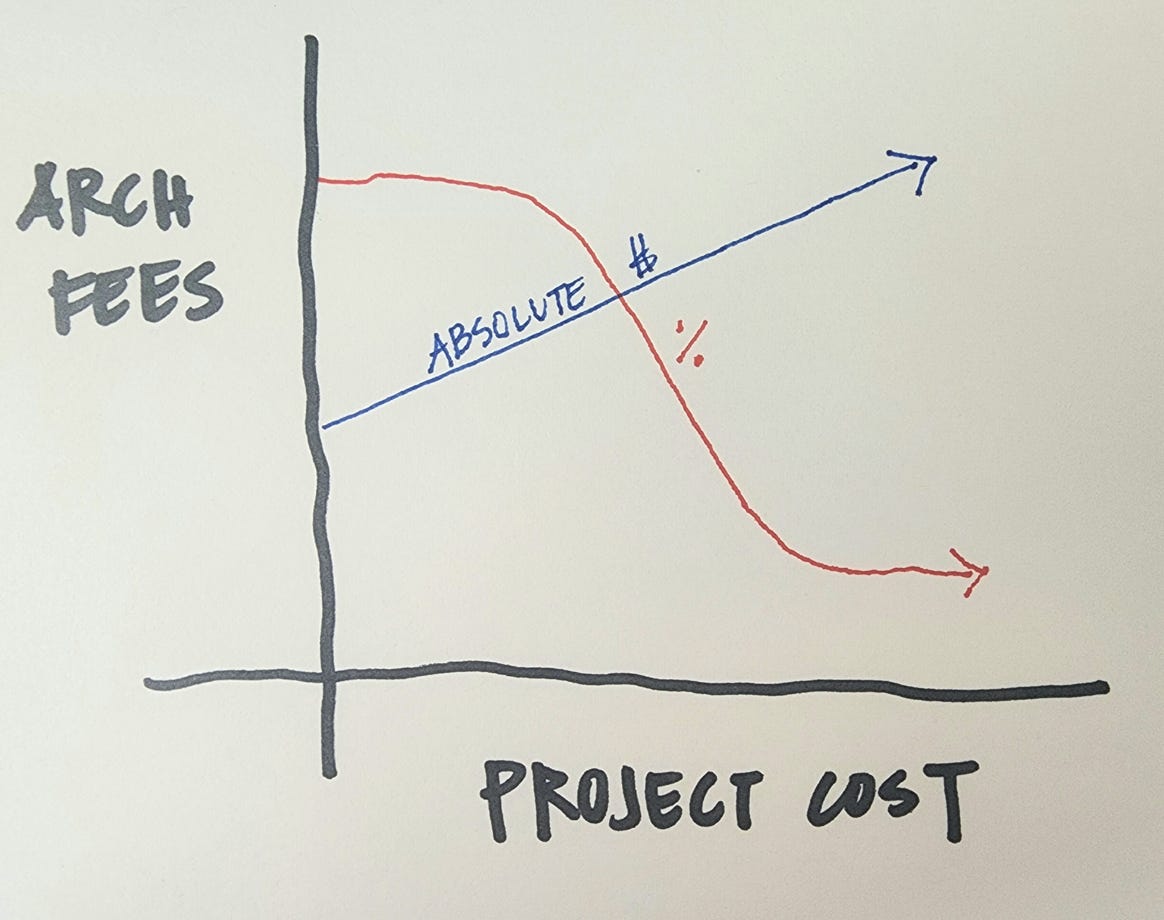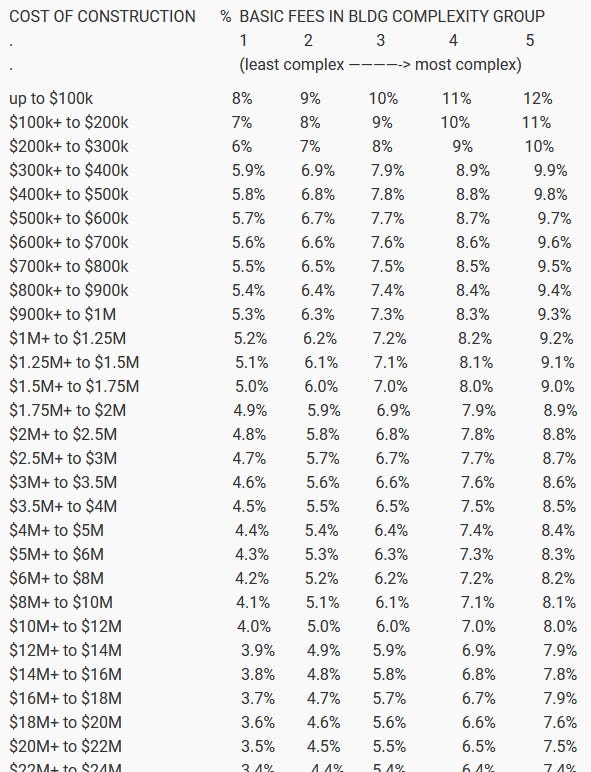A reader dropped me a line and asked if I could do a post on architectural fees [good idea, thanks Erin!] - and I thought it was a great idea for a topic. Architectural fees are shrouded in mystery - for those who hire architects, and for architects themselves! Turns out, it’s *really* hard to accurately price architectural services, and it’s hard to know if you’re getting a good deal when you don’t have a lot of experience hiring architects.
But - that doesn’t mean you can’t get to clear and fair pricing for architectural services - it’s definitely possible! Let’s dive in.
First, why are architectural services hard to price accurately? A few reasons:
A clear picture of what work is needed isn’t always available at the start of a project, when fees are being negotiated;
A large percentage of the architect’s fees are paid before developers’ financing kicks in;
On renovation projects, it’s impossible to know ahead of time what challenges or problems are lurking behind walls;
Most homeowners and small business owners who need architectural services have never worked with an architect, and are completely unfamiliar with the process;
Popular press like HGTV and DIY blogs erase the work of architects, who are often required in projects that are depicted;
Every jurisdiction has different requirements, and may at any time require an architect to be involved in even a small project like a single family renovation;
Folks misunderstand what they’re paying for - not “the drawings” but “architectural services,” which encompass a lot more than just “the drawings';”
Folks underestimate how much coordination will be needed on a construction project, even on relatively uncomplicated ones;
etc, etc, etc.
In short, it’s awfully hard to price something when you don’t know what the project fully entails, and it’s hard to know what you should be paying when you don’t quite understand what you’re buying.
So let’s talk about what architectural services include:
Pre-design services, such as zoning analysis, feasibility studies, parcel test fitting, and the like
Application packages for various regulatory processes, such as zoning, historic commission, development commission/design review boards, neighborhood meetings, and of course, building permit
Design and construction drawings, from initial schematic drawings and renderings to final construction documents, including plans, elevations, sections, technical and aesthetic details, code analysis, zoning analysis
Coordination of all engineers and consultants, and their drawings, including civil, mechanical, plumbing, electrical, structural, acoutiscal, fire protection/fire alarm, energy modeler, envelope, landscape architect, and/or specialty consultants for things like commercial kitchens, theaters/auditoria, elevators, etc.
Coordination of interior design, either in-house [which would generally be beyond “basic” architectural services"] or with an outside consultant/designer
Coordination of contractor bids
Construction contract coordination, including construction observation, handling issues, substitutions, submittals, order review, shop drawing review, and the like during construction; filing field reports; coordinating engineers through construction; handling changes and updates to the design during construction
And…perhaps the most misunderstood and hidden aspect of what architects do for their clients…take on liability on behalf of their clients. When an architect stamps a drawing, that stamp [which is issued by the state they practice in, and must be earned through an arduous process] indicates that the architect accepts responsibility for the project meeting code. If it doesn’t, or if there is some issue, the architect is *personally* liable. Explaining all that in detail would take a whole ‘nother post, but suffice it to say, this is why architects carry a lot of insurance!
Notice that only a couple of those bullet points explicitly include “making drawings” - the rest of the work is a ton of coordination.
So…how do architects charge for that?
Believe it or not, there’s a short answer.
Historically, architects have charged a fixed percentage, based on the cost of construction. So, if the architect is charging 10% for their services, and the project is $1,000,000, the architect’s fee is $100,000.
Turns out, “% of cost of construction” is still industry standard for how fees are set.
In custom residential architecture, the tradition has long been 15%. Note the letter below, from Marcel Breuer’s office [an awesome and famous mid-century architect] with a bit more information about what that fee includes [and doesn’t include].
Today, 15% is a great price for full architectural services for a custom home. Include full interior design services, and/or work with a fancy architect, and that fee can climb to 25%.
For commercial projects, the percentage is usually lower, and for simple industrial projects, the percentage can be as low as 3%.
Tying the fee to cost of construction helps tie the amount of architectural work needed to the size and scope of the project - most basically, the more expensive the project, the more work the architect will have to do. That means that as the project increases, the architect’s fee increases, since they’re doing more work to design, coordinate, answer questions, etc as the scope has increased.
That said, for projects above a certain dollar amount, the architect’s percentage actually goes down.
So, the more expensive the project, the more fee you’ll pay, but the percentage will decrease. For a custom home renovation under $500k, for example, the fee might be 17%, but above $1,000,000, the fee might drop to 14%.
As you can see, agreeing on the percentage is a very important thing, and understanding how and why those percentages are set is crucial. The best write up and explanation I’ve seen on this topic is here: www.architecturalfees.com - seriously - it's amazing, and you should read it all!
Here’s a chart from architecturalfees.com, illustrating the sliding scale of percentage, based on complication of project and size of project:
Some owners are nervous to agree to a fee for architectural services that isn’t quoted as a dollar amount - they want to know on Day 1 what the full fee will be. While that is understandable, unless the scope is 100% clear [which is impossible for any project], or the project is very simple, it will not be possible to give a dollar amount.
One of the biggest variables in determining fees for architectural services is…the owner! A good owner who’s decisive, clear, and pleasurable to work with will enjoy lower fees from all their consultants - running a tight, efficient ownership team, not changing their minds, and being clear with goals and expectations are all key. As soon as owners are capricious, difficult, or unkind [which includes arguing at every turn about reasonable invoices], the project will suffer. This is why trusty, repeat clients get the best pricing.
Here at Runcible, we have adopted a “hybrid” pricing model, that fixes the price for certain phases and relies on a percentage for other phases where we have less control or where the project scale isn’t quite clear yet. Each phase is tied to a clear scope, so that everyone knows what they’re getting for the fee.
For example, during the schematic design phase, we might indicate that we’ll do three rounds of design revision for the stated fee, and any revisions beyond that would be charged hourly [and we would only proceed to the hourly portion of the work with the owner’s written permission].
We handle stuff like zoning, approvals, and the like as hourly, as we have no control over how the process goes - that’s in the hands of the jurisdiction, and they’re not usually known for their speed, efficiency, or clarity!
We fix the price of construction documents, usually as a percentage. If we exceed that fee, that’s on us [unless it’s because of owner or contractor delays], so we’re incentivized to provide efficient service. That said, we charge hourly “additional services” for stuff that is out of our control - owner directed changes, contractor shenanigans, and the like.
Pricing architectural services is not easy - it’s often not fully clear at the outset what the full scope will entail, the architect and owner are unknown to each other, and it’s a type of service that most people aren’t that familiar with in the first place. A good architect will be honest and forthright with a potential client about what their services are, what they think the owner might need, and will consider the owner’s needs first and foremost.
That’s what we try to do here at Runcible, though we often get told by owners “how it is” only to see them flounder later…which is very frustrating! Owners can easily fall prey to design and construction folks who are telling them what they want to hear, rather than the truth - so if you’re getting quotes that are wildly different than the percentages given on architecturalfees.com, take a step back and ask:
Have I fully explained the scope?
Are the quotes I’m getting covering the scope I asked for, or are they leaving things out?
If there’s a big difference between architect #1’s quote and architect #2’s quote, are they quoting the same scope? Are they providing the same level of service?
For architects who are trying to price their services, lean on these percentages. They’re tried and true for a reason. And DO NOT undersell yourself, and make sure to factor in your market. If you think you’re going to need to do a lot more work to execute a project, be clear with the owner right away. DO NOT enter into a contract that will starve you from day 1 [a good owner won’t want that anyway!]
For owners who are tempted to squeeze the architect’s fees to make their proforma work better, or to save a few bucks on their home renovation, remember that you’re just shooting yourself in the foot. The architect is *your representative* - we go to bat for owners, we’re in the trenches all through construction, on the owner’s side. And real talk - architects are pretty severely underpaid for the amount of education and expertise they have. Architects are not getting rich off your project….just compare what car the architect drives with what the GC drives…! Pay them fairly, and reap the rewards of a passionate, whip-smart professional in your corner.
And remember - what an architect is paid for isn’t just “the drawings” or even liability protection [although both of those are very important] - they’re paid for experience and expertise. I can do something in an hour because I have 20 years’ experience. In the end, paying appropriately [and being compensated appropriately] for experience and expertise saves everyone money and hassle in the end.
Thank you for subscribing! I’m so grateful for your support. Please consider sharing with others who might be interested!








Those fees are low... 🫣😵💫
But this was another great read!
Excellent post. I've been following your socials for a while (I think we have a common friend?? I went to Northeastern U).
I'm an architect in rural Maine (Meldrum Design); pricing (and working) as a licensed architect is an interesting dance up here. I ended up creating my own frankenstein process and pricing that seems to work for my budget restricted clients. The pricing is basically hourly with an estimate at the beginning. (I actually just wrote about it on my own blog!)
But architecting up here is like the wild east. Almost no building codes, contractors generally dislike architects, no one has enough money for a designer, etc. It's been a fun challenge figuring out how to make design accessible for everyone who wants one. I love it.
Anyway, thanks for spreading the knowledge. I'm excited to be a subscriber/ supporter. :)